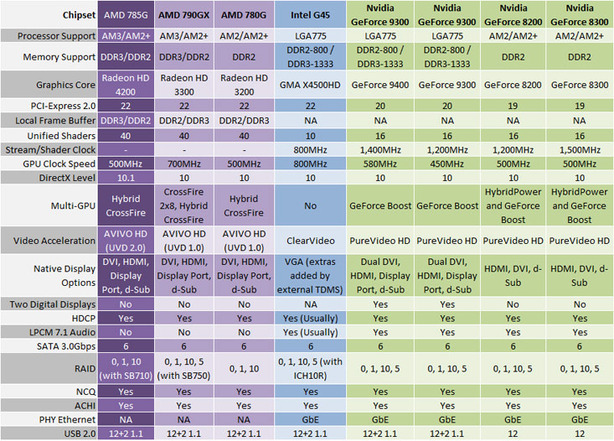
Feature Table
The single PCI-Express 2.0 x16 link cannot be split into two x8s, but hybrid CrossFire is still supported. More importantly though, there are six PCI-Express 2.0 x1 links available as well for plenty of peripheral options: either from x4 or x1 slots, multiple Gigabit Ethernet and Firewire, etc.Expect the 785G to be paired with the new SB710 southbridge rather than the more expensive SB750, as the single difference only extends to RAID 5 support on the latter, which certainly doesn't add much to mainstream boards. Natively there are still six SATA 3Gbps ports with RAID 0, 1, 0+1 and JBOD support, but no SATA 6Gbps options are included yet - they will arrive with the 8-series southbridge.
For the SB710 there's the usual 12 USB 2.0 and two 1.1 ports (requested for portable products), and in testing we've found the USB to be slightly faster than before. However, it still lags behind Nvidia and Intel in terms of performance.
High-Definition audio is at the board manufacturer's discretion, but as usual AMD supports the Intel Azalia specification in addition to the HDMI 1.3 pass-through for protected HD audio. Finally, there's also a PATA port included, still, and there's ACPI 3.0 support for the latest hibernation/sleep and power states.
In terms of overclocking we do definitely recommend the SB710 over SB700 because of Advanced Clock Calibration (ACC) support. This combined with its latest K10/K10.5 architecture products (Phenom, Phenom II, Athlon II) enables either the ability to potentially overclock a bit further or, (more importantly) on certain motherboards, unlock the extra cores on dual and tri-core products if you're lucky enough.
Radeon HD 4200 Graphics Core
Inside the 785G is a Radeon HD 4200 graphics core with DirectX 10.1 support, an upgrade from the HD 3200 and DX10 support on the 780G, but it's still based on the older R600 architecture: specifically we've moved from RV610 to RV620. The core clocks and shader counts are the same at 40 (eight five way superscalar shader units) running at 500MHz, but most of the performance comes from the addition of the AM3 socket and DDR3, affording marginally greater bandwidth to the frame buffer.With a good motherboard we've easily seen an overclock to 700MHz on the IGP, although since we've seen 1GHz last year from the 780G in watercooled and heavily overvolted scenarios, there's clearly plenty to play with from TSMC's 55nm process.
Since the core upgrade is marginal, there's not the crucial change to allow dual digital outputs. With this lack of future proofing, AMD is not only behind the times, it's trailing Nvidia's GeForce 9300/9400 IGP. While we respect in a budget build two monitors are unlikely, and a HTPC will only want to use the HDMI out, it stops more elaborate multiple monitor builds, or business environments where it greatly increases productivity.
Aside from this there are a few core enhancements: multiple stream support (picture in picture), HD video post processing from video sharpening and noise reduction, "colour vibrancy and flesh tone enhancements". Again, this is something those invested in hardcore home theatres will benefit from, especially if you're into buying Blu-rays, but for anyone not investing in high end kit and HD media to really take advantage of it, it does not afford significant change.
Stream?
We've never tried ATI Stream support on 780G, or, much of anything else for that matter because the software has always been few and far between. AMD claims "new" Stream support on 785G, so for some software from Cyberlink, Arcsoft, Adobe (CS4) and ATI (Avivo) itself. Respectively, this is still some way off what Nvidia offers with CUDA, but we still object to fundamentally closed systems, limiting software choice, and will always encourage cross platform OpenCL support.All in all, AMD's 785G is a successful evolution, but we can't help but feel we've been left a little short changed. There's no more core graphics performance, and AM3 support is arbitrary at best - there isn't even dual digital output included still. The new HD features are useful for HTPC enthusiasts who invest in Blu-ray media, but the proportion of users who will benefit is very small.
Read our review of Gigabyte's GA-MA785GMT-UD2H motherboard

MSI MPG Velox 100R Chassis Review
October 14 2021 | 15:04











Want to comment? Please log in.